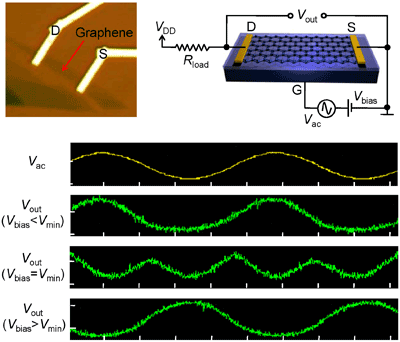Triple-mode graphene yields more versatile transistors
Rice researchers say graphene could become key component in future electronics, supplanting silicon
The wide-ranging capabilities of graphene could lead to circuit applications that are far more compact and versatile than what is now feasible with silicon-based technologies, according to researchers at Rice University. Triple-mode, single-transistor amplifiers based on graphene — the one-atom-thick form of carbon — could become the key components in future electronic circuits.
Graphene is very strong, nearly transparent and conducts electricity very well. It also features ambipolarity, the ability to switch between using positive and negative carriers on the fly depending on the input signal. Traditional silicon transistors usually use one or the other type of carrier, which is determined during fabrication.

Top left: A graphene transistor with source and drain electrodes; top right, a schematic for the triple-mode single-transistor graphene amplifier; and bottom, a graph showing the three distinct modes of operation. (Images courtesy of Mohanram Lab/Rice University)
A three-terminal single-transistor amplifier made of graphene can be changed during operation to any of three modes at any time using carriers that are positive, negative or both, providing opportunities that are not possible with traditional single-transistor architectures, The graphene transistor can be “n-type” (negative) or “p-type” (positive), depending on whether the carrier originates from the source or drain terminals (which are effectively interchangeable). A third function appears when the input from each carrier is equal: The transistor becomes a frequency multiplier. By combining the three modes, the researchers demonstrated such common signaling schemes as phase and frequency shift keying for wireless and audio applications.
“Our work, and that of others, that focuses on the applications of ambipolarity complements efforts to make a better transistor with graphene,” said Kartik Mohanram, an assistant professor of electrical and computer engineering at Rice. “It promises more functionality.” The research demonstrated that a single graphene transistor could potentially replace many in a typical integrated circuit, he said. Graphene’s superior material properties and relative compatibility with silicon-based manufacturing should allow for integration of such circuits in the future, he added.
Technological roadblocks need to be overcome, Mohanram said. Such fabrication steps as dielectric deposition and making contacts “wind up disturbing the lattice, scratching it and introducing defects. That immediately degrades its performance (limiting signal gain), so we have to exercise a lot of care in fabrication.” For more information, go to http://pubs.acs.org/doi/abs/10.1021/nn1021583.
Paul O’Shea
Advertisement
Learn more about Electronic Products Magazine





